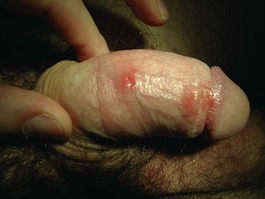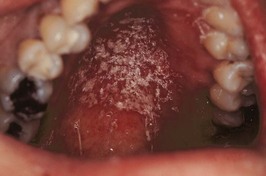Problem 51 Management of a young man who is HIV positive
The partner is also found to be HIV antibody positive and has similar hepatitis serology. The partner describes a painless lesion on the tip of his penis which has been present for 10 days (Figure 51.1).
On examination he appears thinner than previously and looks depressed. He is afebrile. His oral mucosa is coated with numerous thick white plaques (Figure 51.2). He has generalized lymphadenopathy, the nodes being 1–2 cm in size. You refer him to a hospital infectious diseases clinic. His blood screens reveal his haemoglobin has dropped to 112 g/L but his complete blood count is otherwise normal, his CD4+ lymphocyte count has dropped to 210 cells/µL and the HIV viral load is >200 000 copies/µL.





